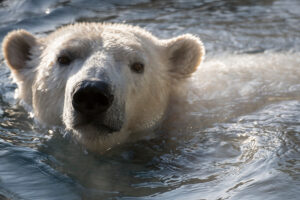
Young polar bear will be out this week, but viewing opportunities will be up to her
PORTLAND, Ore. — She made a big splash when she arrived here in 2016, and we missed her big-time when she went away. Now, as the Oregon Zoo puts the finishing touches on its new Polar Passage habitat, Nora the polar bear is back!
Beginning Thursday, April 1, the zoo will open public walkways around the new polar bear habitat, which officially opens later this spring. In the meantime, guests may get some up-close looks at Nora as she explores, splashes around or naps in her new home. Fans should keep in mind that viewing opportunities will be up to Nora herself, who may prefer to be in her behind-the-scenes den areas at times.
“Visitors might see quite a bit of her in the coming weeks, but it’s all up to Nora,” said Amy Cutting, who oversees the zoo polar bear area. “We know everyone is excited to see her, and we really appreciate their patience and understanding.”
Although there is no set schedule for when Nora might be out, she is typically most active before 11 a.m., according to keepers. Cutting cautions that visitor viewing could close again if Nora needs additional quiet time. Updates will be posted as quickly as possible to the zoo’s website.
Nora was born Nov. 6, 2015, at the Columbus Zoo and Aquarium, and — when her mother began leaving her unattended in the den for prolonged periods of time —Columbus caregivers made the difficult but necessary decision to step in and hand-rear the tiny cub, feeding her from a bottle until she was old enough to eat on her own.
She came to Portland in September 2016, briefly spending time with the Oregon Zoo’s geriatric polar bear Tasul, before moving to the Hogle Zoo, where caregivers introduced her to Hope, another female bear who is the same age as her.
Hope moved from Hogle to Chicago’s Brookfield Zoo last month on a recommendation from the Association of Zoos and Aquariums’ Species Survival Plan for polar bears — a cooperative program that helps maintain a genetically diverse, self-sustaining population to guarantee the long-term future of these animals. Another female polar bear will join Nora at Polar Passage this fall.
In the meantime, Nora and her Oregon Zoo keeper staff can get reacquainted and familiar with the new habitat, which was conceived partly with her in mind.
Polar Passage is one of eight major projects made possible by the community-supported zoo bond measure passed in 2008. The final three projects — improved habitats for primates, rhinos and polar bears — are all set to open this year.
Many of the features at Polar Passage were funded through the Oregon Zoo Foundation’s $8.5 million Heart of the Oregon Zoo campaign, which supports zoo’s animal welfare, conservation and education efforts. To learn more or to make a gift, call 503-220-2493 or email foundation@oregonzoo.org.
To see a video about the new habitat, go to bit.ly/PolarPassage. To learn more about Nora’s story, go to bit.ly/SecondChanceNora.
As climate change reduces Arctic sea ice, polar bears struggle to find and catch seals, making it harder for them and their cubs to survive. The species is classified as threatened under the U.S. Endangered Species Act, and the International Union for the Conservation of Nature’s Species Survival Commission has designated the species as facing a high risk of global extinction.
The zoo is working with Polar Bears International, the U.S. Geological Survey and other partners on projects that will shed new light on how climate change is affecting polar bears in the Arctic. In 2011, Oregon Zoo polar bears became the first in the world to participate in voluntary blood draws — a significant advance that improves animal welfare, especially during veterinary treatment. Since then, the zoo has helped USGS researchers study how climate change is affecting the diets of wild polar bears and develop methods to remotely investigate how these predators are responding to the retreat of sea ice.
As part of the Metro family, the Oregon Zoo helps make greater Portland a great place to call home. Committed to conservation, the zoo is currently working to save endangered California condors, Oregon silverspot butterflies, Taylor’s checkerspot butterflies, western pond turtles and northern leopard frogs.
The Oregon Zoo Foundation is leading efforts to fund critical needs of the zoo during its limited-capacity reopening. To contribute, go to oregonzoo.org/donate. Members, donors and corporate and foundation partners help the zoo make a difference across the region and around the world.
No Comments
Leave a comment Cancel